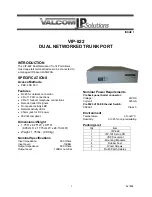
2-6 Riverstone Networks RS 3000 Switch Router Getting Started Guide
Software Overview
Introduction
2.3.4
Layer-4 Switching
In addition to layer-2 bridging and layer-3 routing, the RS 3000 performs layer-4 switching. Layer-4 switching is based
on applications and flows.
Layer-4 Applications
– The RS 3000 understands the application for which an IP or IPX packet contains data and
therefore enables you to manage and control traffic on an application basis. For IP traffic, the RS 3000 looks at the
packet’s TCP or UDP port number to determine the application. For IPX packets, the RS 3000 looks at the destination
socket to determine the application.
Layer-4 Flows
– The RS 3000 can store layer-4 flows on each line card. A layer-4 flow consists of the source and
destination addresses in the IP or IPX packet combined with the TCP or UDP source and destination port number (for
IP) or the source and destination socket (for IPX). You can therefore manage and control individual flows between
hosts on an individual application basis.
A single host can have many individual layer-4 entries in the RS 3000. For example, an IP host might have separate
layer-4 application entries for email, FTP, HTTP, and so on, or separate layer-4 flow entries for specific email
destinations and for specific FTP and Web connections.
2.3.5
MPLS Support
Multi Protocol Label Switching (MPLS) is supported on the RS 8000/8600 through software and through hardware on
the G8M-GBCMM-02 Gigabit Ethernet line cards. The following MPLS capabilities are supported on the
RS 8000/8600:
•
Complete Label Edge Router (LER) and Label Switching Router (LSR) functionality with no impact
on performance
•
Label generation and swapping, along with push and pop operations for supporting multiple levels
of label stacking
•
Tunneling of layer-2 Ethernet over MPLS
•
Support for thousands of label switched paths
•
Support for static and dynamic creation of LSPs
•
Label Distribution Protocol (LDP) and Resource Reservation Protocol with Traffic Engineering
(RSVP-TE) for label distribution and dynamic Label Switched Path (LSP) creation with support for
LDP over LDP and LDP over RSVP, allowing different tunneling schemes
•
Standby LSPs and fail over
•
Traffic engineering extensions to OSPF and IS-IS, along with Constrained Shortest Path First
(CSPF)
2.3.6
Security
The bridging, routing, and application (layer-2, layer-3, and layer-4) support described in previous sections enables
you to implement security strategies that meet specific needs. For layer-2, a wide range of bridging filters are available.
Additionally, all layers can be protected using Access Control Lists (ACLs) filters. You can implement the following
types of filters and ACLs to secure traffic on the RS 3000:
•
Layer-2 source filters (block bridge traffic based on source MAC address)
•
Layer-2 destination filters (block bridge traffic based on destination MAC address)
•
Layer-2 flow filters (block bridge traffic based on specific source-destination pairs)
















































